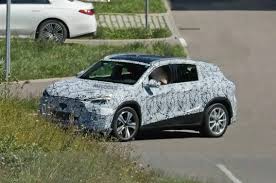Mercedes-Benz is preparing a big update for its popular GLA compact SUV. The next-generation model, expected in 2027, will be built on the brand-new Mercedes Modular Architecture (MMA) platform. This advanced platform is special because it can support petrol, mild-hybrid, and fully electric powertrains, giving buyers more choice. Production of the new GLA will continue at Mercedes-Benz’s Rastatt plant in Germany, alongside the new CLA range.

Powertrain Choices for All Types of Buyers
Mercedes will offer two main versions in the upcoming GLA range:
- Fully Electric GLA EQ – Scheduled for a late 2026 launch.
- Mild-Hybrid GLA – Arriving in early 2027.
This dual strategy means Mercedes is catering to both EV enthusiasts and buyers who still prefer petrol engines with electrification support.
The GLA EQ – A High-Tech Electric SUV
The electric version, known as GLA EQ, will use next-generation battery technology and an 800-volt electrical system. This will help deliver:
- Over 35% more driving range compared to the current electric models.
- A target of up to 720 km (WLTP) range on a single charge.
- Ultra-fast charging at speeds up to 320kW, allowing a 10–80% charge in just about 15 minutes.
Another advanced feature will be bi-directional charging (V2H, V2G, and V2V), which means the SUV can act as a power source for your home, other vehicles, or even feed electricity back into the grid.
Battery Options for Different Needs
Entry-level GLA EQ versions may use LFP (Lithium Iron Phosphate) batteries from companies like CATL or BYD. These batteries are known for:
- Better performance in cold weather.
- Longer charging life cycles.
- Ultra-fast 4C charging capabilities for quick top-ups.
The Mild-Hybrid GLA – Blending Petrol and Electric Power
For buyers not ready to move to a full EV, Mercedes will also launch a 48V mild-hybrid petrol GLA. This system will improve fuel efficiency and provide smoother acceleration while keeping running costs lower than traditional petrol SUVs.
Sporty and Aerodynamic Design
The 2027 GLA will feature a more sporty and aerodynamic look, inspired by the Concept CLA. Expected design highlights include:
- A sloping roofline for a coupe-like silhouette.
- Sleek D-pillars for a modern touch.
- An illuminated front grille that gives a futuristic appearance.
- Improved aerodynamics to help boost efficiency and range.
Why This Update Is Important for Mercedes
The compact luxury SUV segment is becoming more competitive, with brands like BMW, Audi, and Volvo pushing electric and hybrid options. By offering three different powertrain choices in one model family, Mercedes is:
- Keeping traditional petrol buyers interested.
- Attracting new EV customers.
- Staying competitive in global markets, especially in regions pushing for electrification.
Conclusion
The next-generation Mercedes-Benz GLA is shaping up to be one of the most versatile compact luxury SUVs in the market. With petrol, mild-hybrid, and fully electric versions, it aims to meet the needs of a wide range of customers. The electric GLA EQ promises long range, ultra-fast charging, and cutting-edge battery tech, while the mild-hybrid version keeps options open for those who still prefer petrol engines.
With its futuristic design, advanced features, and flexible powertrain options, the 2027 GLA could become a top choice for luxury SUV buyers worldwide.
FAQs
When will the new Mercedes-Benz GLA launch?
The fully electric GLA EQ will launch in late 2026, while the mild-hybrid GLA will arrive in early 2027.
What is special about the GLA EQ?
It will feature next-gen batteries, up to 720 km range, ultra-fast 320kW charging, and bi-directional charging capabilities.
Will there still be a petrol version of the GLA?
Yes, a mild-hybrid petrol version with a 48V system will be available for those not ready to switch to full EV.
Where will the new GLA be produced?
Production will continue at the Mercedes-Benz plant in Rastatt, Germany.
What platform will the new GLA use?
It will be built on the Mercedes Modular Architecture (MMA), which supports ICE, hybrid, and electric powertrains.

